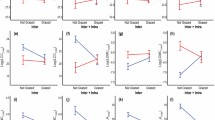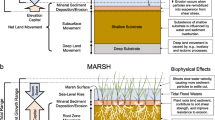Abstract
In many temporary wetlands such as those on the Northern Tablelands of New South Wales Australia, the development of plant communities is largely the result of germination and establishment from a long-lived, dormant seed bank, and vegetative propagules that survive drought. In these wetlands the pattern of plant zonation can differ from year to year and season to season, and depth is not always a good indicator of the plant community composition in different zones. In order to determine which aspects of water regime (depth, duration or frequency of flooding) were important in the development of plant communities an experiment using seed bank material from two wetlands was undertaken over a 16 week period in late spring–early summer 1995–1996. Seed bank samples were exposed to 17 different water-level treatments with different depths, durations and frequencies of flooding. Species richness and biomass of the communities that established from the seed bank were assessed at the end of the experiment and the data were examined to determine which aspects of water regime were important in the development of the different communities. It was found that depth, duration and frequency of inundation influenced plant community composition, but depth was least important, and also that the duration of individual flooding events was important in segregating the plant communities. Species were grouped according to their ability to tolerate or respond to fluctuations in flooding and drying. The highest biomass and species richness developed in pots that were never flooded. Least biomass and species richness developed in pots that were continuously flooded. Short frequent floods promoted high species richness and biomass especially of Amphibious fluctuation-tolerator species and Amphibious fluctuation-responder species that have heterophylly. Terrestrial species were able to establish during dry phases between short floods. Depth was important in determining whether Amphibious fluctuation-tolerator or Amphibious fluctuation-responder species had greater biomass. Longer durations of flooding lowered species richness and the biomass of terrestrial species. Experiments of this kind can assist in predicting vegetation response to water-level variation in natural and modified wetlands.
Similar content being viewed by others
References
Anonymous 1993. Minitab for Windows. Release 9. Minitab Inc. State College P.A.
Bornette, G. & Amoros, C. 1996. Disturbance regimes and vegetation dynamics: role of floods in riverine wetlands. J. Veg. Sci. 7: 615–622.
Bornette, G., Henry, C., Barrat, M-H. & Amoros, C. 1994. Theoretical habitat templets, species traits and species richness: aquatic macrophytes in the Upper Rhone River and its flood plain. Freshwater Biol. 31: 487–505.
Boulton, A. J. & Brock, M. A. 1999. Australian Freshwater Ecology: Processes and Management. Gleneagles Publishing, Adelaide, Australia.
Britton, D. L. & Brock, M. A. 1994. Seasonal germination from wetland seed banks. Aust. J. Marine Freshwater Res. 45: 1445–1458.
Brock, M. A. 1986. Adaptation to fluctuations rather than extremes of environmental parameters. Pp. 131–140. In De Decker, P. & Williams, W. D. (Eds), Limnology in Australia. CSIRO/Junk, Canberra/Denmark.
Brock, M. A. 1991. Mechanisms for maintaining persistent populations of Myriophyllum variifolium J. Hooker in a fluctuating shallow Australian lake. Aquatic Bot. 39: 211–219.
Brock, M. A. 1998. Are temporary wetlands resilient? Evidence from seed banks of Australian and South African wetlands. Pp. 193–206. In: McComb, A. J. & Davis, J. A. (Eds), Wetlands for the Future: Contributions from INTECOL's V International Wetlands Conference. Gleneagles Publishing, Adelaide.
Brock, M. A. & Britton, D. L. 1995. The role of seed banks in the revegetation of Australian temporary wetlands. In: Wheeler, B. D., Shaw, S. C., Fojt, W. & Robertson, R. A. (Eds), Restoration of Temperate Wetlands. John Wiley & Sons, Cambridge.
Brock, M. A., Smith, R. G. B. & Jarman, P. J. 1999. Drain it, dam it: alteration of water regime in shallow wetlands on the New England Tableland of New South Wales, Australia. Wetlands Ecol. Manag. 7: 37–46.
Brock, M. A., Theodore, K. & O'Donnell, L. 1994. Seed bank methods for Australian wetlands. Aust. J. Marine Freshwater Res. 45: 483–93.
Bunn, S. E., Boon, P. I., Brock, M. A. & Schofield, N. J. 1997. National Wetlands R & D Program Scoping Review. Land and Water Resources Research and Development Corporation Occasional Paper 01/97 Canberra.
Casanova, M. T. 1993. The Ecology of Charophytes in Temporary and Permanent Wetlands: An Australian Perspective. Unpublished PhD Thesis, University of New England, Armidale, NSW, Australia. 319 pp.
Casanova, M. T. and Brock, M. A. 1990. Germination and establishment of charophytes from the seed bank of an Australian temporary lake. Aquatic Bot., 36: 247–254.
Chesterfield, D. A. 1986. Changes in the vegetation of the river red gum forest at Barmah, Victoria. Aust. Forestry 49: 4–15.
Connell, J. H. 1978. Diversity in tropical rainforests and coral reefs. Science 199: 1302–1310.
Denton, M. & Ganf, G. G. 1994. Response of juvenile Melaleuca halmatororum to flooding: management implications for a seasonal wetland, Bool Lagoon, South Australia. Aust. J. Marine Freshwater Res. 45: 1395–1408.
Dixon, W. J, Brown, M. B., Engleman, L. & Jenrich, R. T. 1990. BMDP Statistical Software Manual. University of California, Berkeley.
Haworth, R. J., Gale, S. J., Short, S. A. & Heijnis, H. 1999. Land use and Lake sedimentation on the New England Tablelands of New South Wales, Australia. Aust. Geog. 30: 51–73.
Keddy, P. A. & Reznicek, A. A. 1986. Great Lakes vegetation dynamics: the role of fluctuating water levels and buried seeds. J. Great Lakes Res. 12: 25–36.
Mitchell, D. S. & Rogers, K. H. 1985. Seasonality/aseasonality of aquatic macrophytes in southern hemisphere inland waters. Hydrobiologia 125: 137–150.
Rea, N. & Ganf, G. G. 1994. How emergent plants experience water regime in a Mediterranean-type wetland. Aquatic Bot. 49: 117–136.
Roberts, J. 1994. Riverbanks, plants and water management. Pp. 1–7. In: Roberts, J. & Oliver, R. (eds), The Murrumbidgee, Past and Present. CSIRO Water Resources, Griffith.
Schneider, R. 1994. The role of hydrologic regime in maintaining rare plant communities of New Yorks coastal plain pondshores. Biol. Cons. 68: 253–260.
Smith, R. G. B. 1998. The effect of water regime on Juncus articulatus L. and Glyceria australis C.E.Hubb. in the New England Lagoons. Unpublished PhD Thesis. University of New England, Armidale, NSW Australia.
Smith, R. G. B. & Brock, M. A. 1996. Coexistence of Juncus articulatus L. and Glyceria maxima C.E. Hubb. in a temporary shallow wetland in Australia. Hydrobiologia 341: 147–151.
Spence, D. H. N. 1967. Factors controlling the distribution of freshwater macrophytes with particular reference to the lochs of Scotland. J. Ecol. 55: 147–170.
Tabacchi, E. 1995. Structural variability and invasions of pioneer plant communities in riparian habitats of the middle Ardour River (SW France). Can. J. Bot. 73: 33–44.
van den Brink, F. W. B., van der Velde, G., Bossman, W. W. & Coops, H. 1995. Effects of substrate parameters on growth responses of eight helophyte species in relation to flooding. Aquatic Bot. 50: 79–97.
van der Valk, A. G. 1981. Succession in wetlands: a Gleasonion approach. Ecology 62: 688–696.
van der Valk, A. G. & Davis, C. B. 1978. The role of seed banks in the vegetation dynamics of prairie glacial marshes. Ecology 59: 322–335.
Weiher, E. & Keddy, P. A. 1995. The assembly of experimental wetland plant communities. Oikos 73: 323–335.
Author information
Authors and Affiliations
Rights and permissions
About this article
Cite this article
Casanova, M.T., Brock, M.A. How do depth, duration and frequency of flooding influence the establishment of wetland plant communities?. Plant Ecology 147, 237–250 (2000). https://doi.org/10.1023/A:1009875226637
Issue Date:
DOI: https://doi.org/10.1023/A:1009875226637




